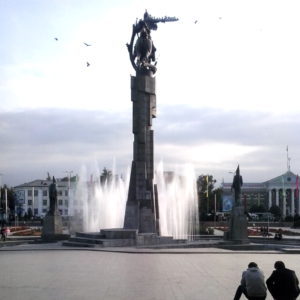Missions history in Kyrgyzstan
Christianity has a long and rich history in Central Asia – from early church traditions about the apostle Thomas passing through on his way to India, to the first Nestorian Christian missionaries centuries later who preached the gospel and even established centers for missionary work – the gospel has had a powerful influence on the land from ancient times.
Many Central Asians worshiped Christ from then up through the eighth century. However, the Arabs forcibly made their way into Central Asia in the year 751, where they fought and won a decisive battle in western Kyrgyzstan. From there, they conquered and forcefully converted not only the Kyrgyz, but ALL of the Central Asian peoples to Islam.
Wave after wave of Islamization followed, and Christianity’s foothold in Central Asia was soon lost. Even the Mongol invasions of the 13th century and the communist Soviet takeover in the 19th century could not wipe out Islam’s powerful influence.
Except for small pockets of Protestant Russian believers, as well as a handful of German Mennonites and South Koreans* that Lenin deported to Central Asia who worshiped in secret, the church was all but non-existent in Kyrgyzstan throughout most of the 20th century.
In 1991, however, the USSR fell, and missionaries rushed in to all the former Soviet states, including the newly formed nation of Kyrgyzstan. Evangelical Christian missionaries from the US and Korea labored hard – especially in personal evangelism, church planting, establishing seminaries, and community development in education, medicine, and agriculture – and the church grew rapidly!
Besides the large churches planted in the country’s capital, Bishkek, hundreds of smaller churches were planted across the rest of the country where the vast majority of Kyrgyzstan’s population lives. From the 1990s on, church growth was dramatic. By 2009, about 22,000 Kyrgyz had converted from Islam to Christianity.
A vibrant, multi-ethnic church sprung up, but numerous setbacks followed in the 2000s. The country’s leadership passed oppressive laws to regulate and restrict evangelism and church gatherings. Even greater persecution and hardship came from local community and Muslim leaders. On top of this, the church faced various internal struggles, which ranged from a high profile scandal in the nation’s largest church to disagreements and disputes in the small house churches.
There are now over 40,000 evangelical Christians among Kyrgyzstan’s population of 6 million people, but the rate of growth has slowed significantly since the 1990’s. There are still over 20 people groups in the country that are less than 0.1% Christian and many of these have no active witness or even an established church.
As the most free of the five Central Asian republics, there is great potential for growth, but it will take courage, wisdom, and sacrifice from the local church and foreign mission agencies.
In detail:
Population: About 6 million
Capital: Bishkek, abt 2 million
Peoples: 47 (57% unreached)
Official languages: Kyrgyz and Russian
Languages: 32
Religion
Largest Religions:
Muslim – 88%
Christians – 5.3%
– Mostly Orthodox
– Only 0.7% of these are evangelical Christians
A primarily Muslim nation (89%), Kyrgyzstan’s cultural identity is tightly associated with its Islamic faith. Yet many continue to practice ancestor worship. The Occult, demonic forces, and shamans also hold many in further bondage. Christianity is claimed by only about 5%, the majority being Orthodox. Though the Church in Kyrgyzstan was once primarily expatriate, today Kyrgyz believers make up a significant portion!
The Christian faith saw great growth after Communism. And although this growth has slowed, the Church is maturing. Hundreds of Protestant congregations now exist, as well as many unregistered house churches. Kyrgyz Muslims are often resistant to the Gospel, even intimidating believers through property destruction and physical violence. But the prevalent needs of the poor, disabled, and elderly provide an open door for the Body of Christ to manifest the love of Jesus to “the least of these.”
Current spiritual needs
– Passion, creativity, and courage in evangelism. The spirit of evangelism prevalent among local believers in the 1990’s has mostly died down. This is a significant reason that church growth has slowed. We need a renewal of this spirit – willing to face down the local authorities and associated risks, as well as the severe disapproval of peers, friends, and immediate and extended family, all for the sake of Christ.
– Deeper and more fruitful men’s ministry, especially among young men and heads of households, and in the Kyrgyz language. Kyrgyz men need to see His work and His power to give freedom from sin, healing from hurts, and provision for all things. We need fresh and powerful testimony in the lives of Kyrgyz men of all ages, that they might be bold and wise servant leaders for the church and the country.
– Holiness, faith, purity, and integrity to stand strong in a culture of pervasive corruption and infidelity. We need brothers and sisters who will live so differently that their lives and character will shine like lights in the darkness and brokenness of the culture around them, and thus bring attention to the gospel.
– Hope, drive, and desire to stay in Kyrgyzstan and grow the local church to stem the flow of local believers immigrating to other nations for better jobs and better opportunities. Generally, local work and higher education opportunities lack sufficient pull to keep young people in the country. We need a generation of believers with a God-given vision to make Christ known in Kyrgyzstan to stay by faith, trusting God to provide for their futures and to protect them from family opposition.
– More resources in the Kyrgyz language. The gospel is too often dismissed as a Russian or foreign thing, rather than a message for all people including them!
– Potentially greater use of methods and church forms geared towards oral learners. Though the Soviet Union brought formal education and literacy to the vast majority of the population, most people tend towards audio-visual ways of learning.
The local church needs in Kyrgyzstan needs deep, Biblical, and engaging ways to reach people in ways that (1) speak to them individually and (2) are easily pass-on-able, even to reach non-city dwelling friends and relatives.

